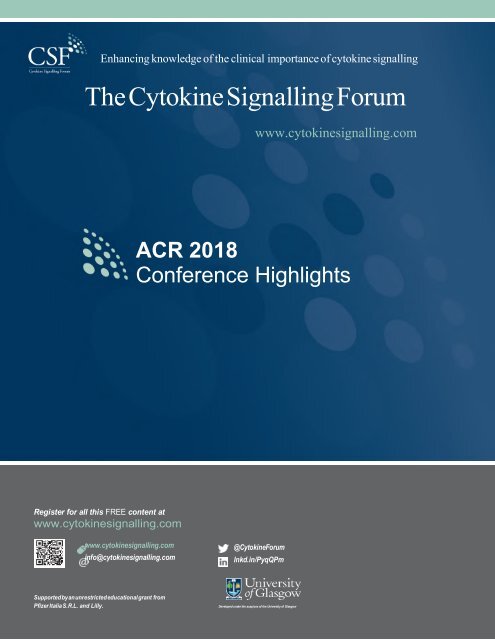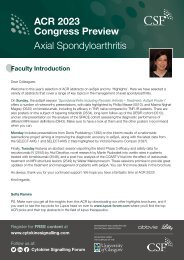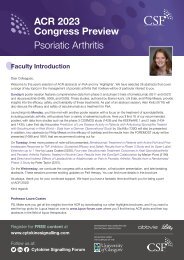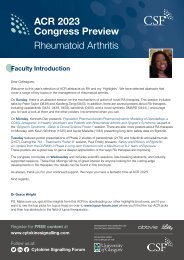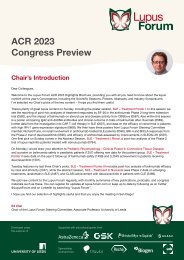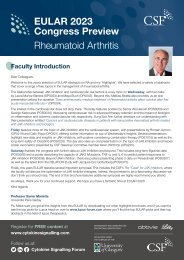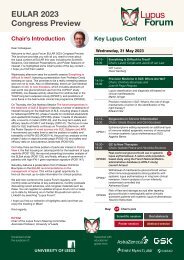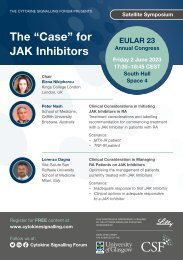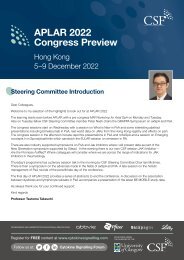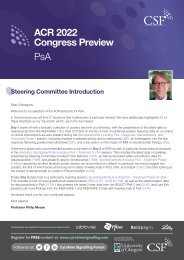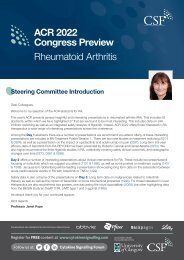ACR 2018 Congress Review
You also want an ePaper? Increase the reach of your titles
YUMPU automatically turns print PDFs into web optimized ePapers that Google loves.
Enhancing knowledge of the clinical importance of cytokine signalling<br />
The Cytokine Signalling Forum<br />
www.cytokinesignalling.com<br />
<strong>ACR</strong> <strong>2018</strong><br />
Conference Highlights
<strong>ACR</strong> <strong>2018</strong><br />
Conference Highlights<br />
Chairman’s Welcome<br />
Dear CSF Member,<br />
It is my pleasure to welcome you to our review of the <strong>ACR</strong> <strong>2018</strong> highlights, which includes my ‘Chairman’s Picks’: abstracts<br />
presented at <strong>ACR</strong> that I feel have the most significant impact on cytokine signalling science.<br />
This year it was exciting to see more data supporting the use of JAK inhibitors in rheumatoid arthritis, with new Phase 3 data<br />
released for two JAK inhibitors in late stage development. Two Phase 3 peficitinib abstracts are presented with results from<br />
two different patient populations; DMARD inadequate responders [#887] and methotrexate inadequate responders [#888].<br />
In addition, upadacitinib Phase 3 data continues to be presented following the abstracts at EULAR earlier this year. Smolen<br />
presents data on upadacitinib monotherapy in methotrexate inadequate responders [#889], followed by van Vollenhoven<br />
investigation of upadacitinib monotherapy in methotrexate-naïve patients [#891]. The upadacitinib Phase 3 data also includes<br />
an upadacitinib comparison study in methotrexate inadequate responders, presented by Fleischmann [#890].<br />
Updates on the long-term safety profile of baricitinib are presented in a 6-year integrated safety analysis presented by<br />
Genovese [#962], with a focus on cardiovascular safety discussed by Weinblatt [#2815].<br />
Similar data is presented on tofacitinib with in a longer-term safety analysis study containing data up to 9.5 years [#963].<br />
Cardiovascular disease risk associated with tofacitinib was evaluated in comparison to csDMARD in patients with RA<br />
[#2817], and herpes zoster risk is analysed in an abstract by Curtis, using data over a 5-year period [#885]. Tofacitinib clinical<br />
effectiveness is also evaluated, in an observational cohort by Cohen [#580].<br />
We also have long-term safety data on filgotinib in patients with RA, using data up to 132 weeks [#2551]. Outside RA,<br />
filgotinib is showing positive Phase 2 data in psoriatic arthritis and in csDMARD inadequate responders presented by Mease<br />
[#1821].<br />
Here, we provide a review of the highlights from <strong>ACR</strong> <strong>2018</strong>, including my ‘Chairman’s Picks’. As always, thank you for your<br />
continued support of the Cytokine Signalling Forum and we hope you enjoyed your time at <strong>ACR</strong> this year!<br />
Yours,<br />
Prof. Iain McInnes
Highlights from <strong>ACR</strong> <strong>2018</strong><br />
During the <strong>ACR</strong> <strong>2018</strong> annual meeting, many presentations and posters reported on cytokine signalling<br />
and related drugs. This document reviews the highlights.<br />
Oral presentations – <strong>ACR</strong> Concurrent Abstract Sessions<br />
Plenary Session II<br />
Filgotinib in cDMARD-IR PsA: Phase 2 study results<br />
Mease and colleagues presented the findings of a 16-week Phase 2 randomised, placebo-controlled trial<br />
evaluating filgotinib in patients with PsA and an inadequate response to cDMARDs. For filgotinib and<br />
placebo patients respectively, <strong>ACR</strong>20 response at Week 16 (primary endpoint) was achieved by 80.0%<br />
and 33.3% (p
The results of a third Phase 3 study of upadacitinib versus MTX in MTX-naïve patients with moderate-tosevere<br />
RA (SELECT-EARLY) were reported by van Vollenhoven and colleagues. A total of 947 patients<br />
were randomized 1:1:1 to once-daily upadacitinib at 15 mg or 30 mg, or weekly MTX (titrated by Week<br />
8). Both primary endpoints (<strong>ACR</strong>50 at Week 12 [FDA], or the proportion of patients achieving DAS28-<br />
CRP
RA –Treatments II: Safety<br />
Long-term safety with baricitinib and tofacitinib<br />
Genovese et al. presented the long-term safety and efficacy profile for baricitinib up to 6 years from an<br />
ongoing open-label, long-term extension (OLE) study. This included 3492 patients with RA, with a total<br />
of 7860 patient-years of exposure. AE IR did not increase with increased exposure compared with a<br />
previous analysis in in 2016. Malignancy (excluding non-melanoma skin cancer) IRs were 0.5 and 1.2<br />
for 2 mg and 4 mg, respectively (as-treated analysis) and 0.8 and 0.8 (as-randomized analysis). In the<br />
all-baricitinib-RA group, IRs for gastro-intestinal perforation and tuberculosis were 0.04 and 0.14,<br />
respectively [#962].<br />
Data on the long-term safety of tofacitinib up to 9.5 years were presented by Cohen and colleagues,<br />
representing the largest integrated safety analysis of tofacitinib to date (7061 patients representing<br />
22,875 patient years of tofacitinib exposure). The most common treatment-emergent AEs (MedDRA<br />
v20.0 preferred term) were viral upper respiratory tract infection (17.3%), upper respiratory tract infection<br />
(17.2%), and urinary tract infection (11.8%). The following IRs were reported: SAEs (9.0), serious<br />
infections (2.5), herpes zoster (3.6), opportunistic infections (0.4), TB (0.2), malignancies (0.8), nonmelanoma<br />
skin cancer (0.6), lymphomas (0.1), GI perforations (0.1), MACE (0.4),<br />
DVT (0.12) and pulmonary embolism (0.12). There were 59 deaths (IR 0.3) [#963].<br />
RA – Diagnosis, Manifestations, & Outcomes I: Other Co-Morbidities<br />
Tofacitinib safety: herpes zoster risk by concomitant MTX or GC use<br />
Herpes Zoster (HZ) risk in tofacitinib users with and without MTX and glucocorticoid (GC) use was<br />
evaluated by Curtis et al. MarketScan and Medicare data (2011-2016) was used to identify all<br />
rheumatologist-diagnosed RA patients initiating tofacitinib. In 8030 new tofacitinib users, the crude HZ<br />
incidence with tofacitinib use was numerically lower in the absence of GC (e.g. 3.4/100py with MTX and<br />
3.7/100py without MTX) and an approximately two-fold increased crude incidence of HZ was observed<br />
for tofacitinib users receiving either GCs alone (6.0/100py) or both MTX and GCs (6.5/100py). After<br />
multivariable adjustment, the hazard ratio for HZ associated with tofacitinib was unchanged when given<br />
with MTX but approximately double when tofacitinib was given with GC. These analyses suggest that HZ<br />
risk in tofacitinib users is doubled with GC exposure and that concomitant MTX did not confer increased<br />
risk [#885].<br />
RA – Diagnosis, Manifestations, & Outcomes IV: CV Co-morbidities<br />
Long-term CV safety with baricitinib in RA<br />
An analysis of CV safety in patients treated with baricitinib for up to 6 years was presented by Weinblatt<br />
and colleagues. Data were pooled from 8 Phase 1–3 studies and analysed in three sets: all patients<br />
exposed to any baricitinib dose; studies comparing baricitinib 4-mg QD with placebo up to 24 weeks;<br />
and studies with baricitinib 2 mg and 4 mg QD, including long-term extension data. A total of 3492<br />
patients were exposed to baricitinib (7860 PY), 78.0% for ≥1 year and 51.2% for ≥2.5 years. For arterial<br />
thrombotic events (ATE) and MACE, the frequency of reported events and IRs were low, comparable<br />
across treatments and analysis sets, and did not increase with prolonged exposure. For DVT/PE, 6<br />
events were reported for baricitinib 4 mg and none with placebo during the 24-week placebo-controlled<br />
period. After longer exposure, DVT/PE IRs were comparable between baricitinib 2 mg and 4 mg doses.<br />
In all patients exposed to any baricitinib dose, IRs were stable over time (overall IR 0.53) [#2815].
Incident CVD rates in RA: bDMARDs and tofacitinib versus csDMARDs<br />
Ozen et al reported the comparative effects of bDMARDs and tofacitinib against csDMARDs on incident<br />
CVD. RA patients with ≥1 year participation in FORWARD (1998 through 2017), The National Databank<br />
for Rheumatic Diseases, were assessed for incident CVD. A total of 1561 CV events were identified in<br />
17363 RA patients with a median of 4.1 years of follow-up. The IR of CVD for the entire cohort was 1.78<br />
per 1000 patient-years. In an adjusted model, a significant CVD risk reduction was seen with TNFi (HR<br />
0.79, 95% CI 0.69-0.92) and abatacept (HR 0.53,<br />
95% CI 0.30-0.92) compared to csDMARDs. In analysis of individual TNFi, although all TNFi<br />
tended to be associated with decreased CV risk, only the risk with infliximab (HR 0.81 [0.67-0.98]) and<br />
etanercept (HR 0.78 [0.64-0.95]) reached statistical significance [#2817].<br />
RA – Etiology & Pathogenesis I<br />
IL-6 and JAK-STAT signalling in RA<br />
Hammaker and colleagues assessed how hip and knee fibroblast-like synoviocytes (FLS) in RA differ in<br />
terms of the response to IL-6, to define the functional sequelae of joint-specific epigenetic imprinting.<br />
RNA-seq data from RA FLS lines sourced from hip and knee arthroplasties were normalized and<br />
principal component analysis was performed. The hip and knee FLS segregated after IL-6 treatment,<br />
indicating that joint-specific differences are maintained after IL-6 treatment. Differentially expressed<br />
genes were identified, focusing on hip vs knee differences. Knee FLS had significantly higher P-STAT3<br />
than hip FLS at 30 minutes (p
SLE – Etiology & Pathogenesis I<br />
Baricitinib-associated changes in type 1 interferon gene signature<br />
Dörner and colleagues reported a dose-dependent decrease in the IFN signature in baricitinib-treated<br />
patients with SLE in a Phase 2 trial. A total of 314 patients were randomised to receive baricitinib 2 mg<br />
or 4 mg once daily for 24 weeks. At baseline, 70% of patients had an elevated IFN signature. Both<br />
doses of baricitinib significantly reduced the IFN signature by Week 24 compared with placebo (p≤0.05),<br />
with decreases observed as early as Week 2. In the patients who had a high IFN signature at baseline,<br />
baricitinib 4 mg significantly reduced the IFN signature at Week 12 and Week 24 compared with placebo<br />
(p≤0.01). The effect of baricitinib on IFN signature reduction did not correlate with the observed SLEDAI-<br />
2K-defined clinical improvement at Week 24 [#1894].<br />
SLE – Clinical I: Clinical Trials<br />
Baricitinib in SLE – Phase II<br />
Phase 2 study results for baricitinib in patients with SLE were reported by Wallace and colleagues. In<br />
this placebo-controlled trial, patients with SLE who were receiving stable background therapy were<br />
randomised to receive placebo or baricitinib (2 mg or 4 mg) once daily. At Week 24, a significantly<br />
greater proportion of patients in the baricitinib 4 mg group compared to placebo achieved the primary<br />
endpoint of resolution of SLEDAI-2K arthritis or rash (67% vs 53%,p
Poster Sessions – <strong>ACR</strong> Poster Session A<br />
Rheumatoid Arthritis – Treatments: Strategy and Epidemiology<br />
Baricitinib efficacy in RA<br />
Taylor et al performed an analysis of data from RA-BEAM to assess if patients who received baricitinib<br />
early attained added clinical improvement compared with patients with a delayed start of therapy.<br />
Patients initially randomized to baricitinib 4 mg were considered the early start group and placebo<br />
patients switched at Week 24 or rescued at Week 16 or later were considered to have a delayed start.<br />
The early start group had significantly greater change from baseline up to Week 32 in CDAI and showed<br />
greater and more rapid reduction in CDAI through the first 4 weeks (>50% reduction) compared with the<br />
delayed start group. Similar results were seen for SDAI, DAS28-ESR and DAS28-hsCRP. The authors<br />
concluded that while overall disease activity improvement was similar between groups, early start of<br />
treatment with baricitinib provided faster efficacy [#546].<br />
Fleischmann and colleagues evaluated the percentage of patients originally randomized to baricitinib 2<br />
mg or 4 mg in the Phase 3 RA-BUILD study, and rescued in the study and/or in the long-term extension<br />
study; the clinical benefits post-rescue were also assessed. Fewer patients originally assigned to<br />
baricitinib 4 mg in RA-BUILD required rescue compared to patients assigned to 2 mg (36% versus 52%,<br />
respectively). Disease activity assessed by CDAI and patient-reported pain improved following rescue<br />
from baricitinib 2 to 4 mg: clinically meaningful response rates in CDAI (≤10) and pain improvement<br />
increased and stabilized over time in the baricitinib-treated population. Patients rescued in RA-BEYOND,<br />
after being treated with baricitinib in RA-BUILD, had less disease activity compared to patients rescued<br />
in RA-BUILD, at the time of rescue [#574].<br />
Fautrel et al assessed pain and HAQ-DI for baricitinib monotherapy from a randomized, MTX-controlled<br />
trial (RA-BEGIN) vs adalimumab, tocilizumab, and tofacitinib monotherapy from similar randomized,<br />
MTX-controlled trials in csDMARD/bDMARD naïve RA patients (PREMIER, AMBITION and FUNCTION,<br />
and ORAL-START, respectively). A matching-adjusted indirect comparison approach was used. At<br />
Week 24, baricitinib showed numerically greater improvement over MTX in pain than that for the<br />
bDMARD monotherapies; statistically significant pain improvements were observed for baricitinib vs<br />
adalimumab and tocilizumab. Baricitinib-treated patients showed significantly greater improvement in<br />
HAQ-DI at Week 24 than tocilizumab and adalimumab but not tofacitinib. The results suggest a greater<br />
pain reduction and improved physical function for baricitinib monotherapy vs tocilizumab and<br />
adalimumab monotherapy [#599].<br />
Tofacitinib efficacy and safety in RA<br />
Razmjou and colleagues report the findings of a pilot study that evaluated whether baseline<br />
musculoskeletal ultrasound (MSUS) and multi-biomarker disease activity (MBDA) scores or early<br />
changes can predict 12-week clinical response in patients with RA who are treated with tofacitinib. A<br />
total of 25 patients with RA were treated with open-label tofacitinib 5 mg BID. There was significant<br />
improvement in power Doppler US (PDUS), grey scale ultrasonography (GSUS), MBDA score, DAS28,<br />
and CDAI over 12 weeks (all p
Cumulative probability plots showing clinical and functional efficacy across treatments for patients with<br />
RA in the ORAL Strategy study were presented by Takeuchi et al. The proportion of patients who<br />
achieved responses of <strong>ACR</strong>20, <strong>ACR</strong>50 and <strong>ACR</strong>70 was similar for tofacitinib 5 mg BID plus MTX, and<br />
adalimumab SC 40 mg (every other week) plus MTX every other week but was numerically smaller for<br />
tofacitinib 5 mg BID monotherapy. Responses of approximately ≥<strong>ACR</strong>80 were achieved by a similar<br />
proportion of patients in each treatment group. Reductions from baseline in HAQ-DI were similar across<br />
treatment groups, although a slightly higher proportion of patients who received tofacitinib monotherapy<br />
reported an increase in HAQ-DI compared with other treatments. These data are consistent with the<br />
primary ORAL Strategy findings [#607].<br />
Tofacitinib persistence, adherence and effectiveness were examined by Cohen and colleagues in a<br />
retrospective cohort study of patients with RA by 12-month post-index MTX status (persistent: ≤60-day<br />
gap; discontinued: >60-day gap; interrupted: >60-day gap with ≥1 subsequent MTX claim 12 months<br />
post-index). This analysis of US-based claims data (n=479 patients) showed that patients who initiate<br />
tofacitinib with oral MTX can discontinue MTX with similar persistence, adherence and effectiveness,<br />
and lower RA-related total/pharmacy costs 12-months post-index vs MTX-persistent patients. The<br />
authors caution that these findings are limited by the use of claims data, suggesting that further analysis<br />
with a larger sample size is required [#581].<br />
Remission and radiographic non-progression in patients with early rapid radiographic progression RA<br />
assessed in a single-blind, randomised controlled trial were reported by Kume et al. A total of 39 patients<br />
were randomised to receive either tofacitinib alone or tofacitinib plus intra-articular steroid injection<br />
(IASI); all patients received MTX 10–22 mg/wk). Clinical remission (SDAI
Real-world data for patients with RA from the St. Gallen and Aarau cohort who were treated with<br />
tofacitinib were reported by Mueller et al. A total of 144 patients were included in the analysis, 83.9% of<br />
whom had been exposed to ≥1 biological agent. Tofacitinib was initiated at a dose of 5 mg BID. LDA or<br />
remission was achieved by 58.2% and 49.5% of patients (median 319 and 645 days), respectively;<br />
these rates were significantly higher in patients naïve to biologic agents compared with those preexposed<br />
to biologics. Reasons for discontinuing tofacitinib were insufficient response (n=23), GI<br />
symptoms (n=18), infection (n=5), myalgia (n=2), remission (n=2), headache (2), cough, blue finger<br />
syndrome, intolerance, heart burn, psoriasis, and increased liver enzymes (all n=1). The authors<br />
concluded that tofacitinib is a safe and effective treatment option for patients with RA and that the rate of<br />
patients achieving LDA or remission is significantly higher in patients naïve to biologics [#586].<br />
The results of an observational study of tofacitinib versus TNFis (etanercept, adalimumab or golimumab)<br />
were presented by Hsieh and colleagues; data were sourced from a Taiwanese registry (XTRA; N=211<br />
patients). TNFi initiators had higher baseline median DAS28-ESR and CDAI scores (6.16 and 36.6,<br />
respectively) vs tofacitinib initiators (5.74 and 28.7, respectively) (p
Rheumatoid Arthritis – Animal Models<br />
Discovery of DWP213388, a potent ITK and BTK dual target inhibitor<br />
Jung and colleagues reported the development of a novel interleukin-2-inducible T-cell kinase (ITK) and<br />
Bruton’s tyrosine kinase (BTK) dual target inhibitor, DWP213388. In preclinical in vitro models,<br />
DWP213388 was a potent inhibitor of ITK and BTK (IC values of 1.4 nM and 0.7 nM, respectively) and<br />
was highly selective against ITK and BTK, yet demonstrated low affinity toward EGFR. In a mouse CIA<br />
model, treatment of DWP213388 improved arthritis in a dose-dependent manner and histological<br />
damages in ankle and knee were markedly improved. The authors concluded that DWP213388 may<br />
serve as a next generation therapeutic agent for autoimmune diseases, including RA [#37].<br />
Spondyloarthritis Including Psoriatic Arthritis – Clinical: Imaging, Clinical Studies, and Treatment<br />
Tofacitinib in PsA and RA<br />
A post-hoc analysis examining the effect of tofacitinib 5 mg BID on laboratory values in patients with PsA<br />
or RA was presented by Rigby and colleagues. For analysis of patients with active PsA treated with<br />
tofacitinib (N=348), data were pooled from 2 Phase 3 studies and an ongoing long-term extension study.<br />
For analysis of patients with moderate or severe RA treated with tofacitinib (N=3040), data were pooled<br />
from 8 Phase 2 studies, 7 Phase 3 studies and 1 LTE study. Change from baseline in hematologic<br />
(haemoglobin, neutrophils, lymphocytes) and lipid (LDL-cholesterol, HDL-cholesterol, total cholesterol,<br />
triglyceride) levels and key liver tests (bilirubin, ALT, AST) creatine kinase, creatinine, and C-reactive<br />
protein levels were assessed. Following initial increases/reductions, key laboratory values remained<br />
stable to Month 12 in both PsA and RA, except for a reduction in lymphocyte levels, which stabilized at<br />
later time points (data not shown). In both PsA and RA, ≤3.0% of patients met discontinuation criteria for<br />
any laboratory values [#685].
<strong>ACR</strong> Poster Session B<br />
Rheumatoid Arthritis – Diagnosis, Manifestations, and Outcomes: Diagnosis and Prognosis<br />
Baseline characteristics predict low disease activity with tofacitinib<br />
A post-hoc analysis of the ORAL-Strategy study examined baseline characteristics in MTX-IR patients with<br />
RA who received tofacitinib 5 mg BID monotherapy. Kaine and colleagues reported that baseline covariates<br />
significantly associated with any of the three LDA measures at Month 6 included age, disease severity (e.g.<br />
TJC, DAS28-4[ESR], SDAI and RF/anti-citrullinated protein antibody status) and SF-36 PCS. Multivariable<br />
analyses will be performed to further explore these associations [#1495].<br />
Rheumatoid Arthritis – Treatments: PROs, Safety and Comorbidity<br />
Tofacitinib real-world data<br />
The impact of obesity on the achievement of LDA in RA patients treated with a JAKi was reported in a<br />
poster by Meißner and colleagues. Data were sourced from the German prospective longitudinal<br />
observational cohort RABBIT (Rheumatoid Arthritis: Observation of biologic therapy). In 539 patients<br />
who started treatment with a JAKi (baricitinib, n=355; tofacitinib, n=184), despite lower frequency of<br />
seropositivity, obese patients presented with higher values for DAS28 and fatigue, and had a worse<br />
physical function at baseline. LDA was reached within the first 6 months of treatment by 42% of patients<br />
with normal weight (BMI
Tofacitinib safety and tolerability<br />
In a cohort study, Kume et al showed that tofacitinib monotherapy improved left ventricular mass and<br />
cardiac output in 42 patients with active RA (despite treatment with csDMARDs) and chronic heart<br />
failure. Tofacitinib significantly attenuated left ventricular mass (as measured with cardio-MRI) and<br />
cardiac output, at baseline and 24 weeks; these effects were independent of tofacitinib’s effects on<br />
disease activity. The authors propose that the JAK-STAT pathway may be important for left ventricular<br />
hypertrophy, and that blockade of this pathway by tofacitinib may prevent cardiovascular morbidity and<br />
mortality in patients with RA and chronic heart failure [#1527].<br />
A poster by Curtis and colleagues reported pooled data from two LTE studies (ORAL Sequel and<br />
NCT00661661) in patients with RA. The authors examined patient characteristics associated with<br />
discontinuation of tofacitinib over a 9.5-year period. Patients who discontinued had a longer disease<br />
duration at baseline, and were more likely to use glucocorticoids, be smokers/ex-smokers, and be from<br />
USA/Canada, than completers. Patients who discontinued ≤1year had higher disease activity than those<br />
who discontinued >1 year; and patients who discontinued >1 year had higher disease activity than<br />
completers, supporting close monitoring of patients. Of patients with TEAEs, discontinuation due to<br />
TEAEs was more frequently observed in patients who discontinued during the first year [#1519].<br />
An analysis from the Rhumadata ® clinical database and registry evaluating data from patients exposed<br />
to tofacitinib since the drugs approval in Canada was presented by Choquette and colleagues. In the<br />
131 patients exposed to tofacitinib since its launch, the majority were female (82%) with a mean age and<br />
disease duration at treatment initiation of 58.1 and 11.5 years, respectively. At the time of the analysis,<br />
63% remained on treatment; reasons for stopping were inefficacy (66%), adverse events (21%),<br />
infections (4%) and other/unknown (11%). The 6-, 12-, 24-, and 36-months’ retention rates of patients<br />
treated with tofacitinib were 75.0, 65.4, 54.7, and 52.3%, respectively, and patients treated with and<br />
without MTX had similar retention curves. Patients stopping and remaining on therapy showed<br />
improvements (decreases) of 3.3 and 10.7 units in CDAI, respectively. At their last evaluation, 14.8%, of<br />
patients were in remission, and 3.3%, 55.7% and 26.3% had low, moderate and high disease activity. In<br />
summary, patients showed improvement in their disease activity score compared to baseline and the<br />
addition of MTX did not provide better sustainability over time [#1531].<br />
Tamura and colleagues provided an interim report of tofacitinib safety based on all-case post-marketing<br />
surveillance (PMS) data following approval in Japan. Overall, 3929 tofacitinib-treated patients with<br />
1704.1 patient-years of exposure were included in the 6-month interim analysis. Of these, 22.7%<br />
discontinued treatment, mainly due to AEs (8.9%) or lack of effectiveness (8.5%). One or more AE were<br />
observed in 33.4% of patients; infections were observed in 12.5%. The most frequent AEs were by<br />
system organ class were infections and infestations (12.5%). SAEs occurred in 7.3% of patients.<br />
Malignancy (all causality) was reported in 0.6% of patients. There were 21 deaths (0.5%), of which the<br />
most common causes (including patients with multiple causes listed) were infection (6 cases) and<br />
malignancy (5 cases). Preliminary all-period (36-month) data were also presented. Malignancies<br />
occurred in 1.6% of patients; gastric cancer in 0.2%, lung neoplasm malignant in 0.2%, breast cancer in<br />
0.1% of patients; diffuse large B-cell lymphoma, ovarian cancer, uterine cancer, colon cancer, and<br />
pancreatic carcinoma in 0.1% of patients each. The authors summarised that this interim analysis did<br />
not reveal any new or unexpected safety signals compared with earlier clinical trials [#1515].
In a second poster based on the same PMS dataset, Tamura et al reported the incidence of serious<br />
infarction events (SIEs), Pneumocystis jiroveci pneumonia (PCP), TB, and HZ among Japanese patients<br />
with RA treated with tofacitinib. In the six-month observation period, the most frequently reported AE by<br />
preferred term was HZ (3.7%), including one HZ meningoencephalitis (serious) and two disseminated<br />
HZ (one serious; one non-serious). PCP was reported in 0.4% of patients (15 serious; one non-serious).<br />
There were three TB cases (including one serious bone tuberculosis); no patients with TB had received<br />
chemoprophylaxis with isoniazid before starting tofacitinib. At month 6, 3.3% patients had SIEs; most<br />
common by preferred term were HZ (0.6%), pneumonia (0.6%), PCP (0.4%), and pneumonia bacterial<br />
(0.3%). The authors concluded that the overall incidence rate of SIEs (6.81) was within the range of<br />
rates reported in prior PMS studies of RA biologic treatment [#1516].<br />
Dikranian et al reported an update to an earlier post-hoc analysis describing the frequency and duration<br />
of the most commonly reported non-SAEs in patients with RA treated with tofacitinib 5 mg BID as<br />
monotherapy or in combination with csDMARDs in Phase 3 and 3b/4 studies (ORAL: Step, Solo, Scan,<br />
Sync, Standard, and Strategy). The analysis included 1976 patients receiving tofacitinib 5 mg BID<br />
(monotherapy, n=122; combination therapy, n=559) and 681 patients receiving placebo.<br />
Up to Month 3, the most frequently reported non-serious AEs headache, diarrhoea, nausea, vomiting,<br />
dyspepsia, and upper abdominal pain. The frequency of non-SAEs was comparable for patients<br />
receiving tofacitinib as monotherapy or in combination with csDMARDs. An incidence rate ≥10 was<br />
observed for headache and diarrhoea in patients receiving tofacitinib 5 mg BID, and for nausea in<br />
patients receiving placebo. Overall, non-serious, non-infectious AEs were mild or moderate and<br />
self-limiting [#1537].<br />
The safety and efficacy of tofacitinib in the Central and Eastern European (CEE) subpopulation of the<br />
tofacitinib clinical program was evaluated by Vencovsky et al. A total of 1725 patients from CEE and<br />
5296 patients from the rest of the world (ROW) were included in the safety analyses. TEAEs occurred in<br />
80.5% of CEE patients and 88.9% of ROW patients; SAES occurred in 24.0% and 27.1% respectively;<br />
the most common AE class was infections and infestations, occurring in 55.3% and 66.6%, respectively.<br />
Improvements in composite efficacy measures were numerically greater for ROW versus CEE, whereas<br />
changes in objective measures were more similar. The authors concluded that results were generally<br />
consistent between CEE and ROW sub-populations [#1544].<br />
Baricitinib safety<br />
A poster by Hendricks and colleagues presented an analysis of CRP levels during bacterial infection in<br />
RA patients treated with baricitinib or placebo, using pooled data from the BEAM, BUILD and BEACON<br />
studies. A total of 36 and 30 patients treated with baricitinib and placebo had CRP values during<br />
bacterial infection TEAEs of which 60% were urinary tract infections. In patients treated with baricitinib,<br />
median CRP levels were 6.2 and 3.0 mg/L in the infection and infection-free period (p
Quality of life in RA<br />
Boudhabhay and colleagues reported a systematic review and meta-analysis to compare the effect size<br />
of JAKi and bDMARD versus sDMARDs on quality of life. The results showed better SF-36 PCS and<br />
MCS at 12 weeks with JAKis and bDMARDs compared with sDMARDs; the magnitude of the<br />
improvement over csDMARD in SF-36 PCS was +4.82 with JAKi and +3.99 with bDMARDs;<br />
corresponding improvements in SF-36 MCS were +3.42 with JAKi and +2.99 with bDMARDs. Similar<br />
confidence intervals were observed between JAKi and bDMARDs, suggesting a similar efficiency with<br />
respect to both components of the SF-36 questionnaire [#1525].<br />
Patient Outcomes, Preferences, and Attitudes: Patient-reported Outcomes<br />
DMARDs and JAKis for pain and fatigue in RA<br />
A systematic literature review performed by Ordriozola and colleagues examined data from clinical trials<br />
comparing DMARDs or JAKis (restricted to baricitinib and tofacitinib) to placebo for pain and/or fatigue in<br />
patients with RA. The authors identified 33 randomized controlled trials that evaluated pain VAS and<br />
17 that investigated the FACIT-F score. The results showed that that the beneficial effects over placebo of<br />
JAKi on pain and fatigue is not significantly different than biologic DMARDs, at least during the short-tomiddle<br />
term, corresponding to the duration of clinical trials [#1401].<br />
Measures and Measurement of Healthcare Quality<br />
Tofacitinib for active PsA – a US health economic analysis<br />
Bungey and colleagues report a decision model used to estimate and compare total costs, clinical<br />
responses and per member per month costs between treatment sequences with and without tofacitinib<br />
in patients with moderate-to-severely active PsA with a previous inadequate response to a csDMARD.<br />
The model suggested that including tofacitinib in treatments for csDMARD-IR PsA patients is a costsaving<br />
alternative to treatment sequences without tofacitinib. The inclusion of tofacitinib on formulary for<br />
a payer insuring 1,000,000 individuals could reduce payer costs for PsA advanced therapies by more<br />
than $5 million over two years [#1264].<br />
Cytokines and Cell Trafficking<br />
Preclinical study of a novel MK2 inhibitor<br />
Using ex vivo models of immune mediated arthritis, Kragstrup et al showed that a small molecule MK2<br />
inhibitor changed the secretory profile of synovial fluid mononuclear cells and decreased inflammatory<br />
osteoclastogenesis. The results suggest a role for this MK2 inhibitor in attenuating inflammatory and<br />
destructive arthritis [#983].<br />
Innate immunity<br />
Novel mechanism of action for tofacitinib<br />
Marzaioli et al reported preclinical results suggesting a novel mechanism of action for tofacitinib in RA<br />
and PsA. Pre-treatment of monocyte-derived dendritic cells (Mo-DC) from patients with RA and PsA<br />
inhibited Mo-DC differentiation. Furthermore, the decreased ability of monocytes to differentiate into<br />
dendritic cells translated into a functional impairment of phagocytic ability. NOX5 protein expression was<br />
significantly decreased in pre-treated Mo-DC from PsA patients, and to a lesser extent in cells from RA<br />
patients. The authors proposed that inhibition of Mo-DC development by tofacitinib may alter migration<br />
of DC to the joint and subsequent activation of the immune response [#1018].
Poster Sessions – <strong>ACR</strong> Poster Session C<br />
Rheumatoid arthritis – Etiology and pathogenesis<br />
Baricitinib reduces joint-related biomarkers in RA<br />
A subset of results from 240 patients in the Phase 3 RA-BUILD study were reported by Thudium and<br />
colleagues. Circulating levels of biomarkers from eighty patients per arm (placebo, baricitinib 2 mg or 4<br />
mg) were analysed at baseline, Week 4, and Week 12 to identify markers that are affected by baricitinib<br />
longitudinally. At Week 4, C1M was reduced by 21% from baseline by baricitinib 4 mg compared to<br />
placebo (p
GS-9876 –Phase 2 study in patients with RA<br />
Kivitz and colleagues presented Phase 2 study results of GS-9876, a novel, potent, highly selective, oral<br />
inhibitor of SYK, in patients with active RA and prior IR to MTX or biologic anti-rheumatic drug. Patients<br />
were randomized 1:1:1:1 to receive GS-9876 30 mg, GS-9876 10 mg, selective JAK inhibitor filgotinib<br />
200 mg or matching placebo once daily for 12 weeks on a stable background of oral MTX. For DAS28-<br />
CRP (primary endpoint), a statistically significant reduction from baseline at Week 12 was observed only<br />
in patients receiving filgotinib as compared to placebo. AEs were reported across all groups (37.5% in<br />
the combined GS-9876 arms, 38.1% in filgotinib arm, 40.9% in the placebo arm). No deaths or serious<br />
AEs were reported. In summary, clinical efficacy of GS-9876 in RA was not observed, but GS-9876 was<br />
safe and well-tolerated over a 12-week period in patients with active RA on MTX [#2518].<br />
Upadacitinib efficacy and safety in RA<br />
Findings from the Phase 3 SELECT-NEXT (n=661) and SELECT-BEYOND (n=498) trials on the speed<br />
of response to upadacitinib across disease measures were presented by FitzGerald et al. In these<br />
cohorts of patients with RA and an inadequate response to csDMARDs or bDMARDs, those receiving<br />
upadacitinib at either 15 mg or 30 mg QD were more likely to achieve clinical responses at significantly<br />
earlier timepoints compared with patients receiving placebo. The median times to achieve <strong>ACR</strong>20 were<br />
4 weeks with upadacitinib 15 mg QD, 2–3 weeks with upadacitinib 30 mg QD, and 12 weeks with<br />
placebo. The median time to low disease activity (LDA) by CDAI and SDAI was approximately 12 weeks<br />
across upadacitinib doses and populations; patients receiving placebo did not achieve LDA within 12<br />
weeks. The time taken to achieve various clinical responses was consistent irrespective of having an<br />
inadequate response to csDMARD or bDMARD [#2523].<br />
A second analysis of data from the SELECT-NEXT and SELECT-BEYOND trials was presented by van<br />
Vollenhoven and colleagues. In csDMARD-IR and bDMARD-IR patients with RA, treatment responses at<br />
12 weeks were observed in significantly higher proportions of patients in the upadacitinib group versus<br />
placebo. Favourable effects with upadacitinib were seen in the composite scores (<strong>ACR</strong>50) and the<br />
individual parameters, including PROs and acute-phase reactants [#2541].<br />
The effect of upadacitinib on pain and morning stiffness in patients with RA in the SELECT-NEXT,<br />
SELECT-BEYOND and SELECT-MONO randomized trials, were presented by Wells and colleagues.<br />
Treatment with upadacitinib in combination with csDMARDs versus placebo resulted in significant and<br />
rapid improvements in pain and morning stiffness across different RA patient populations including<br />
csDMARD-IR and bDMARD-IR; similar improvements versus MTX were reported when UPA was<br />
administered as monotherapy. For example, across all 3 trials, statistically significant least squares<br />
mean percent changes from baseline to Weeks 12/14 in pain and duration of AM stiffness were reported<br />
with upadacitinib 15 mg and 30 mg daily (except AM stiffness duration in BEYOND) compared with<br />
placebo or MTX groups. Significantly more upadacitinib-treated patients (15 mg:<br />
30-36%, 30 mg: 36-44%) reported no pain or mild pain at Weeks 12/14 compared with placebo or MTX<br />
(14–15%). Improvements in upadacitinib-treated patients were evident as early as Week 2 [#2524].
Strand et al presented two posters on PROs with upadacitinib. The first poster reported analyses of the<br />
SELECT-NEXT, SELECT BEYOND and SELECT-MONOTHERAPY studies. In general, change from<br />
baseline in pain and HAQ-DI scores were marginally correlated with individual physician-derived measures<br />
and moderate-to-high correlations were observed between pain, HAQ-DI and PtGA in both trials. Regression<br />
analyses showed that improvements in individual disease assessments were associated with significant<br />
improvements in pain at Week 12 and patients with improvement in composite measures were more likely to<br />
report substantial improvements in pain. These findings support the use of PROs in randomised controlled<br />
trials and highlight that their use as distinct parameters may provide additional insights into the true impact of<br />
RA [#2546]. The second poster reported an analysis of data from 648 patients in the SELECT-<br />
MONOTHERAPY trial only. Treatment with upadacitinib 15 mg or 30 mg as monotherapy for 14 weeks<br />
resulted in statistically significant and clinically meaningful improvements in PROs compared with MTX,<br />
including disease activity, pain, physical function, and HRQoL among MTX-IR patients [#2547].<br />
Mohamed and colleagues presented analyses from two Phase 2b studies of upadacitinib in patients with<br />
moderately to severely active RA who had an inadequate response to anti-TNF therapies (BALANCE I)<br />
or MTX (BALANCE II). In 574 patients the percentage of subjects achieving <strong>ACR</strong>50, <strong>ACR</strong>70, LDA, and<br />
clinical remission increased with increasing upadacitinib plasma exposures. Upadacitinib plasma<br />
exposures associated with 6 mg BID to 12 mg BID using the immediate-release formulation (equivalent<br />
to15 mg QD to 30 mg QD using the extended-release formulation, respectively) are predicted to achieve<br />
near maximum efficacy in RA patients while having limited effects on NK cells, haemoglobin, LDL-C, and<br />
HDL-C. Exposures higher than 12 mg BID are not predicted to result in additional efficacy benefits in<br />
subjects with RA, but have the potential for greater effects on laboratory parameters. Results from these<br />
analyses supported the evaluation of extended-release formulation 15 mg and 30 mg QD in Phase 3<br />
trials in RA [#2542].<br />
Baricitinib: efficacy in RA<br />
Pope and colleagues presented data from a post-hoc analysis of the RA-BEACON trial. Baricitinib 2 mg<br />
or 4 mg provided greater pain relief in bDMARD-IR patients with RA compared with placebo. Consistent<br />
results were observed regardless of baseline pain or prior treatment history [#2531]<br />
Rheumatoid Arthritis – Diagnosis, Manifestations, and Outcomes: Complications of Therapy,<br />
Outcomes, and Measures<br />
Tofacitinib safety<br />
Soriano et al reported a prevalence of hepatic steatosis of 1.6% in 10212 patients across the tofacitinib<br />
RA, PsA and PsO programmes (1.3% in RA, 3.8% in PsA and 1.6% in PsO). In both tofacitinib- and<br />
placebo-treated patients, the incidence of elevated total bilirubin, aspartate aminotransferase (AST) and<br />
alanine aminotransferase (ALT) >1x ULN up to Month 3 was higher in patients with hepatic steatosis<br />
than in those without, across indications. The incidence of elevated total bilirubin, AST and ALT >3x<br />
ULN up to Month 3 was low across indications, irrespective of hepatic steatosis [#2447].<br />
The incidence of virus reactivation by tofacitinib in a cohort of patients with RA was reported by Urata<br />
and colleagues. In 35 patients receiving a mean MTX dose of 7.5 mg per week, reactivation rates were<br />
2.9, 8.6, 25.5 and 0% for cytomegalovirus, hepatitis B virus, varicella virus and Epstein Barr virus,<br />
respectively [#2454].
Spondyloarthritis including Psoriatic Arthritis – Clinical: Treatment<br />
Tofacitinib efficacy and safety in PsA<br />
The third interim analysis of OPAL Balance, an open-label LTE study of tofacitinib in patients with PsA,<br />
was reported by Nash et al. Of the 686 patients treated in the study, 468 remained in the study at data<br />
cut-off. To 36 Months, 2189 AEs were reported in 79.6% of patients. SAEs, discontinuations due to AEs<br />
and serious infections were reported in 13.8%, 8.6% and 1.7% of patients, respectively. HZ was<br />
reported in 2.9% of patients, MACE in 0.7%, malignancies in 3.5% (including 12 patients with NMSC)<br />
and uveitis in 0.3%. No AEs of GI perforation or inflammatory bowel disease were reported. There were<br />
5 deaths, none of which were attributed to treatment as assessed by the investigator. The authors<br />
concluded that over 36 months in the LTE, the safety profile of tofacitinib in patients with active PsA was<br />
generally similar to that of the Phase 3 studies. Efficacy was maintained across multiple disease<br />
domains to Month 30 [#2565].<br />
A post-hoc analysis of the OPAL Broaden and OPAL Beyond studies was presented by Ogdie and<br />
colleagues; this analysis examined baseline pain severity as a predictor of pain improvement following<br />
treatment with tofacitinib 5 mg BID and included 236 patients with active PsA who were csDMARD-IR. In<br />
patients with a baseline pain level of 90 mm, the predicted median time to achieve ≥30% pain<br />
improvement was 39.3 days. Whereas, for a baseline pain level of 50 mm, the predicted median time to<br />
achieve ≥30% pain improvement was 56.7 days. Therefore, the time to pain improvement was<br />
dependent upon baseline pain severity, with lower pain scores at baseline associated with longer time to<br />
improvement than higher pain scores. Patients with higher pain severity at baseline achieved clinically<br />
meaningful pain improvements faster than patients with lower severity of pain [#2588].<br />
De Vlam and colleagues presented a post-hoc analysis on data from 2 Phase 3 studies of tofacitinib in<br />
patients with active PsA and inadequate response to ³1 csDMARD (OPAL Broaden) or to ³1 TNFi<br />
(OPAL Beyond). 354 patients who were treated with tofacitinib 5 mg twice daily (BID) and placebo<br />
advanced to tofacitinib 5 mg BID at Month 3 (PBO-tofacitinib), in combination with csDMARDs, were<br />
included in this analysis. Current arthritis pain severity was reported by patients using a 100 mm visual<br />
analog scale. Pain improvement was defined as the first post-baseline improvement of ≥30%<br />
(meaningful change), ≥50% (substantial change), or ≥70% relative to baseline. Analyses showed that<br />
patients receiving tofacitinib 5 mg BID achieved improvements in pain severity of 30–70% significantly<br />
faster compared with patients in the PBO-tofacitinib group. The median time to ≥30% pain improvement<br />
was 55 days in the tofacitinib 5 mg BID group and 106 days in the PBO-tofacitinib group (p=0.0132)<br />
[#2594].<br />
Systemic Lupus Erythematosus – Animal Models<br />
Preclinical studies of filgotinib in lupus<br />
Han et al reported preclinical findings with filgotinib, a JAK1 selective inhibitor, in a murine lupus model.<br />
Filgotinib showed a dose-dependent decrease in proteinuria, a concomitant reduction in renal<br />
inflammation, improved glomerular morphology and increased survival (versus placebo). An alteration of<br />
splenic immune cell subsets affected by type I IFNs towards non-diseased levels was demonstrated for<br />
filgotinib. Filgotinib also normalized renal expression of genes for structural damage, apoptosis,<br />
complement system, and nucleic acid sensing. Importantly, among the 16<br />
type I interferon signature genes measured, 12 showed a dose-responsive decrease with filgotinib<br />
treatment [#2097].
References<br />
• Babaoglu H, Goker B, İnanç N, Birlik M, Koca SS, Cefle A, Dalkiliç E, Tufan A, Yilmaz S, Senel S, Akar S, Akkoc N, Onen F, Gazel U. Impact of<br />
Obesity on Drug Survival of Tofacitinib in Patients with Rheumatoid Arthritis: Analysis from the Turkbio Registry [abstract]. Arthritis Rheumatol.<br />
<strong>2018</strong>; 70 (suppl 10): Abstract 1547.<br />
• de Vlam K, Ogdie A, Bushmakin AG, Cappelleri JC, Fleischmann R, Taylor PC, Azevedo VF, Fallon L, Maniccia A, Woolcott J and Mease PJ. Median<br />
Time to Pain Improvement in Patients with Psoriatic Arthritis Treated with Tofacitinib [abstract]. Arthritis Rheumatol. 2017; 69 (suppl 10): Abstract<br />
2594.<br />
• Boudhabhay M, Barnetche T, Vergne-Salle P. Effect of JAK-Inhibitor Versus Bdmards on Quality of Life in Rheumatoid Arthritis : A Meta Analysis of<br />
Randomized Controlled Trials [abstract]. Arthritis Rheumatol. <strong>2018</strong>; 70 (suppl 10): Abstract 1525.<br />
• Bungey G, Chang-Douglass S, Hsu MA, Cappelleri JC, Young P, Woolcott J. Modeling the Costs and Outcomes Associated with Treatment Sequences,<br />
with and without Tofacitinib, for Moderately to Severely Active Psoriatic Arthritis in the US [abstract]. Arthritis Rheumatol. <strong>2018</strong>; 70 (suppl 10):<br />
Abstract 1264.<br />
• Choquette D, Bessette L, Brown J, Haraoui B, Massicotte F, Pelletier JP, Raynauld JP, Rémillard MA, Sauvageau D, Turcotte A, Villeneuve É, Coupal<br />
L. Tofacitinib Show Similar Retention When Used with and without Methotrexate. Analysis from the Rhumadata® Clinical Database and Registry<br />
[abstract]. Arthritis Rheumatol. <strong>2018</strong>; 70 (suppl 10): Abstract 1531.<br />
• Citera G, Mysler E, Madariaga H, Cardiel MH, Castañeda O, Fischer A, Richette P, Chartrand S, Park JK, Strengholt S, Rivas JL, Thorat A, Girard T,<br />
Kwok K, Wang L, Ponce de Leon D. Low Interstitial Lung Disease Event Rate in Patients with Rheumatoid Arthritis: Pooled Post Hoc Analysis of<br />
Data from the Tofacitinib Clinical Development Program [abstract]. Arthritis Rheumatol. <strong>2018</strong>; 70 (suppl 10): Abstract 525.<br />
• Cohen S, Haraoui B, Curtis JR, Smith T, Woolcott J, Gruben D, Murray CW, Iikuni N, Koenig A, Harnett J. Comparative Analysis of Outcomes<br />
Among Patients with Rheumatoid Arthritis Initiating Tofacitinib in Combination with Oral MTX Who Discontinue, Interrupt, or Persist with MTX<br />
[abstract]. Arthritis Rheumatol. <strong>2018</strong>; 70 (suppl 10): Abstract 581.<br />
• Cohen S, Litman HJ, Chen C, Lukic T, Madsen A, Takiya L, Dandreo KJ, Blachley T, Greenberg J. Clinical Effectiveness of Tofacitinib 11mg Once<br />
Daily (QD) Versus Tofacitinib 5mg Twice Daily (BID) in the Corrona US RA Registry [abstract]. Arthritis Rheumatol. <strong>2018</strong>; 70 (suppl 10): Abstract<br />
580.<br />
• Cohen S, Tanaka Y, Mariette X, Curtis JR, Lee EB, Nash P, Winthrop K, Charles-Schoeman C, Wang L, Chen C, Kwok K, Biswas P, Shapiro A,<br />
Madsen A, Wollenhaupt J. Long-Term Safety of Tofacitinib up to 9.5 Years: A Comprehensive Integrated Analysis of the RA Clinical Development<br />
Program [abstract]. Arthritis Rheumatol. <strong>2018</strong>; 70 (suppl 10): Abstract 963.<br />
• Curtis JR, Wollenhaupt J, Chatzidionysiou K, Tas SW, Wang L, Shi H, Montoro M, Neregård P, Dahl P, Tsekouras V. Patient Characteristics<br />
Associated with Discontinuation of Tofacitinib for the Treatment of Rheumatoid Arthritis in Open-Label, Long-Term Extension Studies up to 9.5 Years<br />
[abstract]. Arthritis Rheumatol. <strong>2018</strong>; 70 (suppl 10): Abstract 1519.<br />
• Curtis JR, Xie F, Bernatsky S, Yang S, Chen L, Yun H, Winthrop K. Herpes Zoster in Tofacitinib Users with and without Concomitant Methotrexate<br />
and Glucocorticoids [abstract]. Arthritis Rheumatol. <strong>2018</strong>; 70 (suppl 10): Abstract 885.<br />
• Dikranian A, Wollenhaupt J, Azevedo VF, Bessette L, Gold D, Rivas JL, Shi H, Wang L, Woolcott J, Shapiro A, Nash P. Frequency and Duration of<br />
Early Non-Serious Adverse Events in Rheumatoid Arthritis Patients Treated with Tofacitinib 5 Mg Twice Daily As Monotherapy and Combination<br />
Therapy [abstract]. Arthritis Rheumatol. <strong>2018</strong>; 70 (suppl 10): Abstract 1537.<br />
• Dörner T, Tanaka Y, Petri M, Smolen JS, Dow ER, Higgs RE, Benschop RJ, Abel A, Silk ME, de Bono S, Hoffman RW. Baricitinib-Associated<br />
Changes in Type l Interferon Gene Signature during a 24-Week Phase-2 Clinical SLE Trial [abstract]. Arthritis Rheumatol. <strong>2018</strong>; 70 (suppl 10):<br />
Abstract 1894.<br />
• Fautrel B, Zhu B, Taylor PC, van de Laar M, Emery P, de Leonardis F, Gaich CL, Nicolay C, Kadziola Z, de la Torre I, Fleischmann R. Comparative<br />
Effectiveness in Pain and HAQ-DI Improvement for Baricitinib Versus Adalimumab, Tocilizumab, and Tofacitinib Monotherapies in Csdmard-Naïve<br />
Rheumatoid Arthritis Patients: A Matching-Adjusted Indirect Comparison (MAIC) [abstract]. Arthritis Rheumatol. <strong>2018</strong>; 70 (suppl 10): Abstract 599.<br />
• Finckh A, Tellenbach C, Scherer A, Moeller B, Ciurea A, von Mühlenen I, Gabay C, Kyburz D, Mueller R, Hasler P, Zufferey P. The Impact of<br />
Comedication with Conventional Synthetic Dmards on Drug Retention and Clinical Effectiveness of Tofacitinib, Anti–Tumor Necrosis Factor Therapy<br />
and Biologics with an Alternative Mode of Action in Patients with Rheumatoid Arthritis. a Cohort Study [abstract]. Arthritis Rheumatol. <strong>2018</strong>; 70<br />
(suppl 10): Abstract 557.<br />
• FitzGerald O, Rubbert-Roth A, Chen K, Meerwein S, Enejosa JJ, Shaw T, Wells AF. Rapid Response with Upadacitinib Treatment in Patients with<br />
Rheumatoid Arthritis and an Inadequate Response to Csdmards or Bdmards [abstract]. Arthritis Rheumatol. <strong>2018</strong>; 70 (suppl 10): Abstract 2523.<br />
• Fleischmann R, Genovese MC, Cardoso A, Sun L, Chen YF, Walls CD, Schlichting DE, Takeuchi T, Dougados M, Smolen JS, Curtis JR. Longitudinal<br />
Efficacy Analysis of Patients with Active Rheumatoid Arthritis and Inadequate Response to Conventional Synthetic Dmards: Response Following<br />
Rescue from Baricitinib 2mg to 4mg Once-Daily [abstract]. Arthritis Rheumatol. <strong>2018</strong>; 70 (suppl 10): Abstract 574.<br />
• Fleischmann R, Pangan AL, Mysler E, Bessette L, Peterfy C, Durez P, Ostor A, Li Y, Zhou Y, Othman AA, Song IH, Genovese MC. A Phase 3,<br />
Randomized, Double-Blind Study Comparing Upadacitinib to Placebo and to Adalimumab, in Patients with Active Rheumatoid Arthritis with<br />
Inadequate Response to Methotrexate [abstract]. Arthritis Rheumatol. <strong>2018</strong>; 70 (suppl 10): Abstract 890.<br />
• Genovese MC, Smolen JS, Takeuchi T, Rooney TP, Dickson CL, Yang XY, Saifan C, Cardoso A, Issa M, Ishii T, Winthrop K. Safety Profile of<br />
Baricitinib for the Treatment of Rheumatoid Arthritis up to 6 Years: An Updated Integrated Safety Analysis [abstract]. Arthritis Rheumatol. <strong>2018</strong>; 70<br />
(suppl 10): Abstract 962.<br />
• Giles JT, Nurmohamed MT, Rinder HM, Krishnan V, Crowe BJ, Saifan C, Dörner T. Mean Platelet Volume Changes with Baricitinib Indicate Reduced<br />
New Platelet Production in Baricitinib-Treated Rheumatoid Arthritis Patients [abstract]. Arthritis Rheumatol. <strong>2018</strong>; 70 (suppl 10): Abstract 1536.
• Hammaker D, Nygaard G, Kuhs A, Ai R, Boyle DL, Wang W, Firestein GS. Joint Location-Specific IL6 and JAK-STAT Signaling in Rheumatoid<br />
Arthritis (RA) Fibroblast-like Synoviocytes (FLS) [abstract]. Arthritis Rheumatol. <strong>2018</strong>; 70 (suppl 10): Abstract 930.<br />
• Han P, Pohlmeyer C, Shang C, Cui Z, Lopez D, Clarke A, Jones R, Mollova N, Mikaelian I, Newstrom D, Zaboli S, Shauf A, Di Paolo J. Monotherapy<br />
with Filgotinib, a JAK1-Selective Inhibitor, Reduces Disease Severity and Alters Immune Cell Subsets in the NZB/W F1 Murine Model of Lupus<br />
[abstract]. Arthritis Rheumatol. <strong>2018</strong>; 70 (suppl 10): Abstract 2097.<br />
• Hendricks O, Chrysidis S, Gerwien J, Saifan C, de Leonardis F, Lopez-Romero P, Zhong J, Winthrop K, Smolen JS. CRP Changes during Bacterial<br />
Infections in Baricitinib-Treated Patients with RA [abstract]. Arthritis Rheumatol. <strong>2018</strong>; 70 (suppl 10): Abstract 1530.<br />
• Hsieh SC, Chen YH, Chen WS, Tsai WC, Hu JC, Chen HC, Mardekian J, Lai C. Real-World Use of Tofacitinib Compared with Tumor Necrosis Factor<br />
Inhibitors in a Cohort of 211 Patients with Rheumatoid Arthritis: Data from a Drug-Based Registry Study in Taiwan [abstract]. Arthritis Rheumatol.<br />
<strong>2018</strong>; 70 (suppl 10): Abstract 629.<br />
• Jung JH, Eom D, Jeon SU, Shin YD, Kim W, Jung J, Li Q, Hyun H, Park JS. Discovery of DWP213388, a Potent ITK and BTK Dual Target Inhibitor<br />
with Excellent Efficacy, As a Treatment for Autoimmune Diseases [abstract]. Arthritis Rheumatol. <strong>2018</strong>; 70 (suppl 10): Abstract 37.<br />
• Kaine J, Kivitz AJ, Mysler E, Iikuni N, Fan H, Diehl A, Paulissen J, Murray CW. Baseline Characteristics of Methotrexate Inadequate Responder<br />
Patients with RA Who Achieved Low Disease Activity with Tofacitinib Monotherapy [abstract]. Arthritis Rheumatol. <strong>2018</strong>; 70 (suppl 10): Abstract<br />
1495.<br />
• Karatas A, Oz B, Dalkiliç E, Can G, Pehlivan Y, Senel S, Yazici A, Inanc N, Erturk Z, Cefle A, Akar S, Koca SS, Birlik M, Onen F. Cigarette Smoking<br />
Does Not Affect Treatment Response to Tofacitinib in Rheumatoid Arthritis [abstract]. Arthritis Rheumatol. <strong>2018</strong>; 70 (suppl 10): Abstract 1554.<br />
• Kavanaugh A, Genovese MC, Winthrop K, Greenwald M, Ponce L, Enriquez Sosa F, Stanislavchuk M, Mazur M, Spindler A, Cseuz R, Nikulenkova<br />
N, Glowacka-Kulesz M, Szombati I, Dudek A, Mozaffarian N, Greer J, Kunder R, An D, Meuleners L, Besuyen R, Alten R, Westhovens R.<br />
Rheumatoid Arthritis Treatment with Filgotinib: Week 132 Safety Data from a Phase 2b Open-Label Extension Study [abstract]. Arthritis Rheumatol.<br />
<strong>2018</strong>; 70 (suppl 10): Abstract 2551.<br />
• Kivitz AJ, Mehta DP, Matzkies F, Mozaffarian A, Kunder R, Di Paolo J, Mozaffarian N, Hsueh S, Kim J, Jiang W, Liu L, Sundy JS, Genovese MC.<br />
GS-9876, a Novel, Highly Selective, SYK Inhibitor in Patients with Active Rheumatoid Arthritis: Safety, Tolerability and Efficacy Results of a Phase 2<br />
Study [abstract]. Arthritis Rheumatol. <strong>2018</strong>; 70 (suppl 10): Abstract 2518.<br />
• Kragstrup TW, Mellemkjær A, Nielsen MA, Heftdal LD, Iversen M, Schafer P, Deleuran B. A MAPK Activated Kinase 2 Inhibitor Attenuates<br />
Inflammatory and Destructive Arthritis in Human Ex Vivo Models [abstract]. Arthritis Rheumatol. <strong>2018</strong>; 70 (suppl 10): Abstract 983.<br />
• Kremer J, Cappelli LC, Etzel CJ, Greenberg J, Geier J, Madsen A, Chen C, Onofrei A, Barr CJ, Pappas DA, Dandreo KJ, Shapiro A, Connell CA,<br />
Kavanaugh A. Real-World Data from a Post-Approval Safety Surveillance Study of Tofacitinib Vs Biologic Dmards and Conventional Synthetic<br />
Dmards: Five-Year Results from a US-Based Rheumatoid Arthritis Registry [abstract]. Arthritis Rheumatol. <strong>2018</strong>; 70 (suppl 10): Abstract 1542.<br />
• Kume K, Amano K, Yamada S, Kanazawa T, Hatta K. Combination of Intra-Articular Steroid Injection and Tofacitinib More Effective Than<br />
Tofacitinib in Rapid Radiographic Progression Patients with Rheumatoid Arthritis [abstract]. Arthritis Rheumatol. <strong>2018</strong>; 70 (suppl 10): Abstract 596.<br />
• Kume K, Amano K, Yamada S, Kanazawa T, Hatta K. Tofacitinib Improves Left Ventricular Mass and Cardiac Output in Rheumatoid Arthritis Patients<br />
with Chronic Heart Failure [abstract]. Arthritis Rheumatol. <strong>2018</strong>; 70 (suppl 10): Abstract 1527.<br />
• Marzaioli V, Canavan M, Floudas A, Wade SC, Low C, Veale DJ, Fearon U. Tofacitinib Impairs Monocyte-Derived Dendritic Cell Differentiation in<br />
Rheumatoid Arthritis and Psoriatic Arthritis. [abstract]. Arthritis Rheumatol. <strong>2018</strong>; 70 (suppl 10): Abstract 1018.<br />
• Mease PJ, Gladman DD, van Den Bosch F, Rychlewska-Hanczewska A, Dudek A, Tasset C, Meuleners L, Harrison P, Besuyen R, Kunder R,<br />
Mozaffarian N, Coates LC, Helliwell P. Filgotinib, an Oral, Selective Janus Kinase 1 Inhibitor, Is Effective in Psoriatic Arthritis Patients with an<br />
Inadequate Response to Conventional Disease-Modifying Anti-Rheumatic Drugs: Results from a Randomized, Placebo-Controlled, Phase 2 Study<br />
[abstract]. Arthritis Rheumatol. <strong>2018</strong>; 70 (suppl 10): Abstract 1821.<br />
• Meißner Y, Baganz L, Schneider M, Schwarze I, Feuchtenberger M, Zink A, Strangfeld A. Baricitinib and Tofacitinib in Real Life – Does Obesity<br />
Impact Response to Janus Kinase Inhibitor Therapy in Rheumatoid Arthritis? [abstract]. Arthritis Rheumatol. <strong>2018</strong>; 70 (suppl 10): Abstract 1518.<br />
• Mohamed ME, Winzenborg I, Doelger E, Noertersheuser P, Camp HS, Meerwein S, Othman AA. Integrated Exposure-Response Analyses for<br />
Upadacitinib Efficacy and Effects on Laboratory Parameters in Rheumatoid Arthritis – Analyses of Phase 2b Studies [abstract]. Arthritis Rheumatol.<br />
<strong>2018</strong>; 70 (suppl 10): Abstract 2542.<br />
• Mueller R, Hasler C, Popp F, Mattow F, Durmisi M, Rubbert-Roth A, Souza A, Graf N, Schulze- Koops H, Hasler P, von Kempis J. Effectiveness,<br />
Tolerability, and Safety of Tofacitinib in Rheumatoid Arthritis: A Retrospective Analysis of Real-World DATA from the ST. Gallen and- Aarau RA-<br />
Cohort [abstract]. Arthritis Rheumatol. <strong>2018</strong>; 70 (suppl 10): Abstract 586.<br />
• Nash P, Coates LC, Kivitz AJ, Mease PJ, Gladman DD, Covarrubias-Cobos JA, Fleishaker D, Wang C, Kudlacz E, Menon S, Fallon L, Hendrikx T,<br />
Kanik KS. Safety and Efficacy of Tofacitinib, an Oral Janus Kinase Inhibitor, up to 36 Months in Patients with Active Psoriatic Arthritis: Data from the<br />
Third Interim Analysis of OPAL Balance, an Open-Label, Long-Term Extension Study [abstract]. Arthritis Rheumatol. <strong>2018</strong>; 70 (suppl 10): Abstract<br />
2565.<br />
• Odriozola I, Coste CS, Barnetche T, Richez C, Bannwarth B, Schaeverbeke T. Is There a Specific Effect of Jak-Inhibitors on Pain and Fatigue in<br />
Rheumatoid Arthritis? [abstract]. Arthritis Rheumatol. <strong>2018</strong>; 70 (suppl 10): Abstract 1401.<br />
• Ogdie A, de Vlam K, Bushmakin AG, Cappelleri JC, Mease PJ, Fleischmann R, Taylor PC, Azevedo VF, Fallon L, Maniccia A, Woolcott J. Baseline<br />
Pain Severity As a Predictor of Pain Improvement Following Treatment with Tofacitinib in Psoriatic Arthritis [abstract]. Arthritis Rheumatol. <strong>2018</strong>; 70<br />
(suppl 10): Abstract 2588.<br />
• Ozen G, Pedro S, Michaud K. Cardiovascular Disease Risk with Biologics and Tofacitinib Compared to Conventional Synthetic Dmards in Patients<br />
with Rheumatoid Arthritis [abstract]. Arthritis Rheumatol. <strong>2018</strong>; 70 (suppl 10): Abstract 2817.<br />
• Patterson SL, Evans M, Aggarwal I, Izadi Z, Gianfrancesco M, Schmajuk G, Yazdany J. Gaps in Patient Safety Performance before Treatment with<br />
Biologic Disease-Modifying Antirheumatic Drugs or Tofacitinib in a Large Academic Healthcare System [abstract]. Arthritis Rheumatol. <strong>2018</strong>; 70<br />
(suppl 10): Abstract 2858.
• Pope JE, Quebe A, Zhu B, Sun L, Gaich CL, de Leonardis F, Cardoso A, Genovese MC. Assessment of Pain Relief with Baricitinib By Treatment<br />
History in Patients with Refractory Rheumatoid Arthritis [abstract]. Arthritis Rheumatol. <strong>2018</strong>; 70 (suppl 10): Abstract 2531.<br />
• Razmjou A, Brook J, Kaeley G, Elashoff D, Ranganath VK. Baseline Power Doppler and Multi-Biomarker Disease Activity Score Predict 12-Week<br />
Disease Activity Response to Tofacitinib [abstract]. Arthritis Rheumatol. <strong>2018</strong>; 70 (suppl 10): Abstract 582.<br />
• Rigby WF, Burmester GR, FitzGerald O, Azevedo VF, Nash P, Hendrikx T, Graham D, Wang C, Jones T. Changes in Key Laboratory Values with<br />
Tofacitinib 5mg BID Treatment in Patients with Psoriatic Arthritis and Rheumatoid Arthritis [abstract]. Arthritis Rheumatol. <strong>2018</strong>; 70 (suppl 10):<br />
Abstract 685.<br />
• Smolen JS, Cohen S, Emery P, Rigby WFC, Tanaka Y, Zhang Y, Friedman A, Othman AA, Camp HS, Pangan AL. Upadacitinib As Monotherapy: A<br />
Phase 3 Randomized Controlled Double-Blind Study in Patients with Active Rheumatoid Arthritis and Inadequate Response to Methotrexate [abstract].<br />
Arthritis Rheumatol. <strong>2018</strong>; 70 (suppl 10): Abstract 889.<br />
• Soriano ER, Madariaga H, Castañeda O, Citera G, Schneeberger EE, Cardiel MH, Hendrikx T, Graham D, Shi H, Ponce de Leon D. Liver Enzyme<br />
Abnormalities after Tofacitinib Treatment in Patients with Hepatic Steatosis from the Rheumatoid Arthritis, Psoriatic Arthritis, and Psoriasis Clinical<br />
Programs [abstract]. Arthritis Rheumatol. <strong>2018</strong>; 70 (suppl 10): Abstract 2447.<br />
• Strand V, Buch M, Tundia N, Camp HS, Suboticki J, Goldschmidt D, Wells AF. Upadacitinib Monotherapy Improves Patient-Reported Outcomes in<br />
Patients with Rheumatoid Arthritis and Inadequate Response to Methotrexate [abstract]. Arthritis Rheumatol. <strong>2018</strong>; 70 (suppl 10): Abstract 2547.<br />
• Strand V, Damjanov N, Scoville C, Tundia N, Camp HS, Chen K, Suboticki J, van Vollenhoven R. The Association between Patient Reported<br />
Outcomes and Clinical Measures Among Rheumatoid Arthritis Patients: Analyses Using Phase 3 Clinical Trials of Upadacitinib [abstract]. Arthritis<br />
Rheumatol. <strong>2018</strong>; 70 (suppl 10): Abstract 2546.<br />
• Takeuchi T, Smolen JS, Fleischmann R, Iikuni N, Fan H, Soma K, Akylbekova E, Hirose T. Clinical and Functional Response to Tofacitinib and<br />
Adalimumab in Patients with Rheumatoid Arthritis: Probability Plot Analysis of Results from the ORAL Strategy Trial [abstract]. Arthritis Rheumatol.<br />
<strong>2018</strong>; 70 (suppl 10): Abstract 607.<br />
• Takeuchi T, Tanaka Y, Tanaka S, Kawakami A, Iwasaki M, Rokuda M, Izutsu H, Ushijima S, Kaneko Y, Shiomi T, Yamada E. Efficacy and Safety of<br />
the Novel Oral Janus Kinase (JAK) Inhibitor, Peficitinib (ASP015K), in a Phase 3, Double-Blind, Placebo-Controlled, Randomized Study of Patients<br />
with RA Who Had an Inadequate Response to Methotrexate [abstract]. Arthritis Rheumatol. <strong>2018</strong>; 70 (suppl 10): Abstract 888.<br />
• Tamura N, Kuwana M, Atsumi T, Takei S, Harigai M, Fujii T, Matsuno H, Mimori T, Momohara S, Yamamoto K, Takasaki Y, Nomura K, Endo Y,<br />
Hirose T, Morishima Y, Sugiyama N, Yoshii N, Takagi M. Malignancy in Japanese Patients with Rheumatoid Arthritis Treated with Tofacitinib:<br />
Interim Analysis of All-Case Post-Marketing Surveillance [abstract]. Arthritis Rheumatol. <strong>2018</strong>; 70 (suppl 10): Abstract 1515.<br />
• Tamura N, Kuwana M, Atsumi T, Takei S, Harigai M, Fujii T, Matsuno H, Mimori T, Momohara S, Yamamoto K, Takasaki Y, Nomura K, Endo Y,<br />
Hirose T, Morishima Y, Sugiyama N, Yoshii N, Takagi M. Infection Events in Japanese Patients with Rheumatoid Arthritis Treated with Tofacitinib:<br />
Interim All-Case Post-Marketing Surveillance [abstract]. Arthritis Rheumatol. <strong>2018</strong>; 70 (suppl 10): Abstract 1516.<br />
• Tanaka Y, Takeuchi T, Tanaka S, Kawakami A, Iwasaki M, Song YW, Chen YH, Rokuda M, Izutsu H, Ushijima S, Kaneko Y, Shiomi T, Yamada E.<br />
Efficacy and Safety of the Novel Oral Janus Kinase (JAK) Inhibitor, Peficitinib (ASP015K), in a Phase 3, Double-Blind, Placebo-Controlled,<br />
Randomized Study of Patients with RA Who Had an Inadequate Response to Dmards [abstract]. Arthritis Rheumatol. <strong>2018</strong>; 70 (suppl 10): Abstract<br />
887.<br />
• Taylor PC, Downie B, Zhuo L, Gindin Y, Tarrant J, Liu J, Galien R, Mirza AM. The JAK1-Selective Inhibitor Filgotinib Reverses the Disease-<br />
Associated Transcriptional Profile Found in the Blood of Patients with Active Rheumatoid Arthritis [abstract]. Arthritis Rheumatol. <strong>2018</strong>; 70 (suppl<br />
10): Abstract 2517.<br />
• Taylor PC, Tanaka Y, Cardoso A, Zhong J, Chen YF, Workman JL, Morales LDC, Schiff M. Baricitinib: Early Vs. Delayed Start in Patients with<br />
Rheumatoid Arthritis [abstract]. Arthritis Rheumatol. <strong>2018</strong>; 70 (suppl 10): Abstract 546.<br />
• Teitsma XM, Jacobs JWG, Concepcion AN, Pethö-Schramm A, Borm ME, van Laar J, Bijlsma JWJ, Lafeber FP. Sustained Drug-Free Remission in<br />
Early RA Following Methotrexate-Based Strategy: Role of the JAK-STAT Pathway [abstract]. Arthritis Rheumatol. <strong>2018</strong>; 70 (suppl 10): Abstract 2899.<br />
• Thudium CS, Bay-Jensen AC, Cahya S, Dow ER, Karsdal MA, Koch AE, Zhang W, Benschop RJ. Effect of Baricitinib on Joint-Related Biomarkers in<br />
Patients with Moderate-to-Severe Rheumatoid Arthritis [abstract]. Arthritis Rheumatol. <strong>2018</strong>; 70 (suppl 10): Abstract 2035.<br />
• Urata Y. Virus Reactivation Rate in Rheumatoid Arthritis Using Tofacitinib [abstract]. Arthritis Rheumatol. <strong>2018</strong>; 70 (suppl 10): Abstract 2454.<br />
• van Vollenhoven R, Dore RK, Chen K, Camp HS, Enejosa JJ, Shaw T, Suboticki J, Hall S. Impact of 12-Weeks of Upadacitinib Treatment on<br />
Individual and Composite Disease Measures in Patients with Rheumatoid Arthritis and Inadequate Response to Conventional Synthetic or Biologic<br />
Dmards [abstract]. Arthritis Rheumatol. <strong>2018</strong>; 70 (suppl 10): Abstract 2541.<br />
• van Vollenhoven R, Takeuchi T, Pangan AL, Friedman A, Mohamed ME, Chen S, Rischmueller M, Blanco R, Xavier RM, Strand V. A Phase 3,<br />
Randomized, Controlled Trial Comparing Upadacitinib Monotherapy to MTX Monotherapy in MTX-Naïve Patients with Active Rheumatoid Arthritis<br />
[abstract]. Arthritis Rheumatol. <strong>2018</strong>; 70 (suppl 10): Abstract 891.<br />
• Vencovsky J, Badurski J, Forejtová Š, Lukáčová O, Stanislavchuk M, Yaneva-Bichovska D, Shi H, Vasilescu R, Lukic T, Kabina M. Tofacitinib<br />
Safety and Efficacy in the Treatment of Rheumatoid Arthritis in a Central/Eastern European Subpopulation [abstract]. Arthritis Rheumatol. <strong>2018</strong>; 70<br />
(suppl 10): Abstract 1544.<br />
• Wallace DJ, Furie R, Tanaka Y, Kalunian KC, Mosca M, Petri M, Dorner T, Cardiel MH, Bruce IN, Gomez E, DeLozier AM, Janes J, Linnik MD, de<br />
Bono S, Silk ME, Hoffman RW. Baricitinib in Patients with Systemic Lupus Erythematosus: Results from a Phase 2, Randomized, Double-Blind,<br />
Placebo-Controlled Study [abstract]. Arthritis Rheumatol. <strong>2018</strong>; 70 (suppl 10): Abstract 970.<br />
• Weinblatt M, Taylor PC, Burmester GR, Saifan C, Walls CD, Issa M, Rooney TP, Takeuchi T. Cardiovascular Safety – Update from up to 6 Years of<br />
Treatment with Baricitinib in Rheumatoid Arthritis Clinical Trials [abstract]. Arthritis Rheumatol. <strong>2018</strong>; 70 (suppl 10): Abstract 2815.<br />
• Weinblatt ME, Taylor PC, Keystone EC, Ortmann RA, Issa M, Xie L, de Bono S, Tanaka Y. Efficacy and Safety of Switching from Adalimumab to<br />
Baricitinib: Long-Term Data from Phase 3 Extension Study in Patients with Rheumatoid Arthritis [abstract]. Arthritis Rheumatol. <strong>2018</strong>; 70 (suppl 10):<br />
Abstract: 886.
• Wells AF, Lee YC, Tundia N, Suboticki J, Chen K, Friedman A, Strand V. Effect of Upadacitinib on Pain and Morning Stiffness in Patients with<br />
Rheumatoid Arthritis and Inadequate Response to Conventional Synthetic or Biologic Disease-Modifying Anti-Rheumatic Drugs [abstract]. Arthritis<br />
Rheumatol. <strong>2018</strong>; 70 (suppl 10): Abstract 2524.<br />
• Yun H, Xie F, Chen L, Curtis JR. Risk of Venous Thrombotic Events in Rheumatoid Arthritis Patients Initiating Tofacitinib or Adalimumab [abstract].<br />
Arthritis Rheumatol. <strong>2018</strong>; 70 (suppl 10): Abstract 224.


